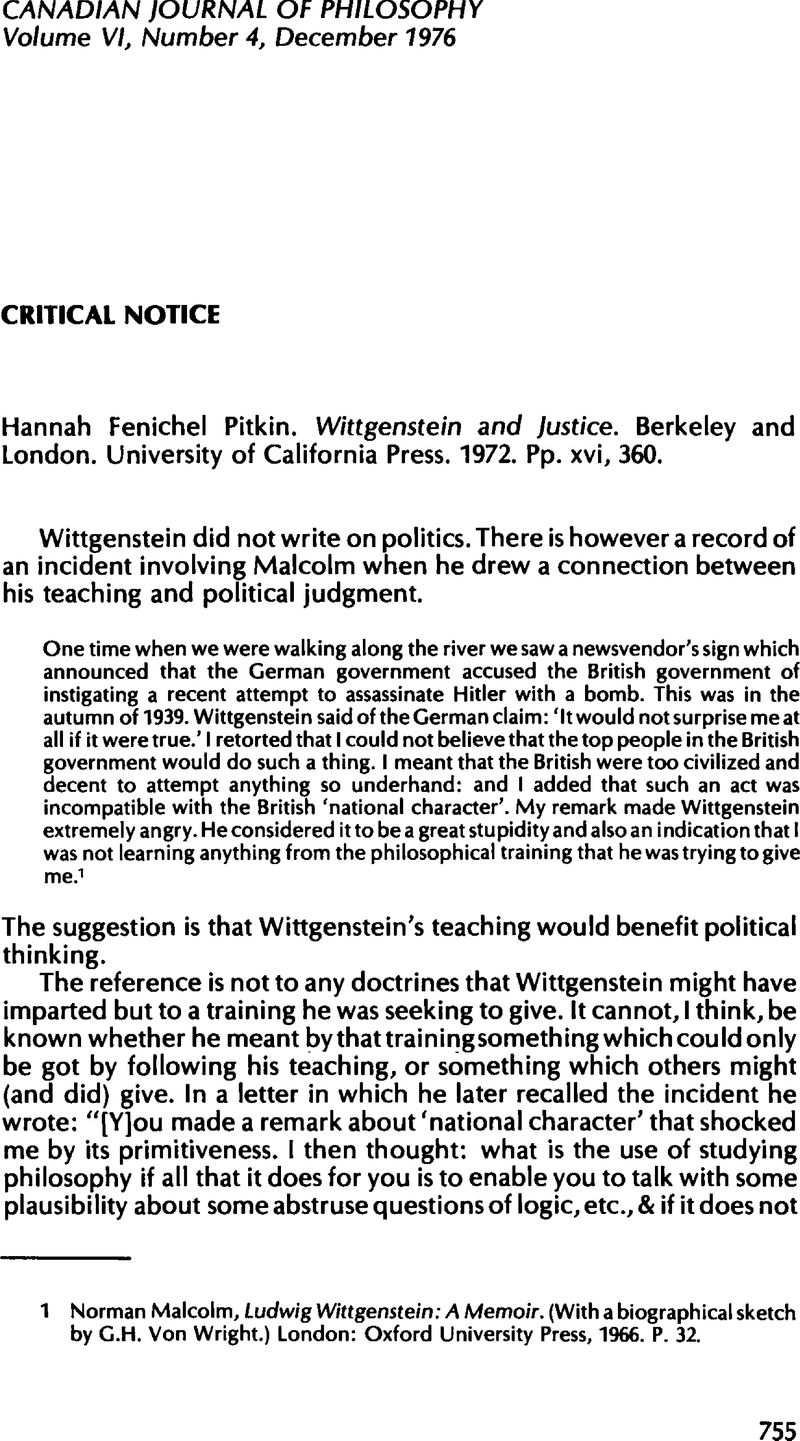No CrossRef data available.
Published online by Cambridge University Press: 01 January 2020

1 Malcolm, Norman Ludwig Wittgenstein: A Memoir.(With a biographical sketch by Wright, G.H. Von.) London: Oxford University Press, 1966. P. 32.Google Scholar
2 See e.g., Philosophical Investigations, Part I, Sec. 339: “Thinking is not an incorporeal process which lends life and sense to speaking, and which it would be possible to detach from speaking, rather as the Devil took the shadow of Schlemiehl from the ground.― But how ‘not an incorporeal process'? Am I acquainted with incorporeal processes, then, only thinking is not one of them? No; I called the expression ‘an incorporeal process’ to my aid in my embarrassment when I was trying to explain the meaning of the word ‘thinking' in a primitive way.“
3 See Pitkin, Hannah Fenichel The Concept of Representation. Berkeley and Los Angeles: University of California Press, 1967.Google Scholar
4 Remarks on the Foundations of Mathematics, Part V, s.49.
5 See Rush Rhees, Correspondence: The Human World,Number 15-16. May-August 1974. P. 162.
6 Very briefly: it would come nearer to representing Wittgenstein's preoccupations to say, not ‘words are not labels but signals', but: a word is a label only in being used, and the point of labelling (i.e. naming) is that it is a preparation for talk. (“[N]othing has so far been done, when a thing has been named. It has not even got a name except in the language game.“ Investigations, Part I, Sec. 49.) Concerning the second thesis, the metaphor of a compound (a composition of different ingredients) is misguiding, since the instances of use referred to are instances of the same use of a word. (The claim is that USE confers meaning; but if each instance were a different use of the ‘word', babel must be the result.) In the third thesis, the words “meaning and use need to be completed by context” blunt the point intended, since they suggest that meaning can first be characterized independently, and then referred to the context to be “completed“; when in fact it is only by (implicit) reference to the context that one can identify the meaning.
7 Plamenatz, John Man and Society. Vol. 2. (London: Longmans. 1963). P. 269Google Scholar, my emphasis.
8 See also the passage from page 3 quoted at the beginning of this section.
9 “In Hopi history, could we read it, we should find a different type of language and a different set of cultural and environmental influences working together. A peaceful agricultural society isolated by geographic features and nomad enemies in a land of scanty rainfall, arid agriculture that could be made successful only by the utmost perserverance (hence the value of persistence and repetition), necessity for collaboration (hence emphasis on the psychology of teamwork and on mental factors in general), corn and rain as primary criteria of value, need of extensive PREPARATIONS and precautions to assure crops in the poor soil and precarious climate, keen realization of dependence upon nature, especially prayer and religion directed toward the ever-needed blessing, rain― these things interacted with Hopi linguistic patterns to mold them, to be molded again by them, and so little by little to shape the Hopi world-outlook.” From “The Relation of Habitual Thought and Behaviour to language”, in Language, Thought and Reality,ed. Carroll, J.B. (Cambridge, M.I.T. Press, 1963), pp. 157–158.Google Scholar
10 Language, Thought, and Reality, p. 216.
11 Ibid., p. 57.
12 Ibid., p. 257.